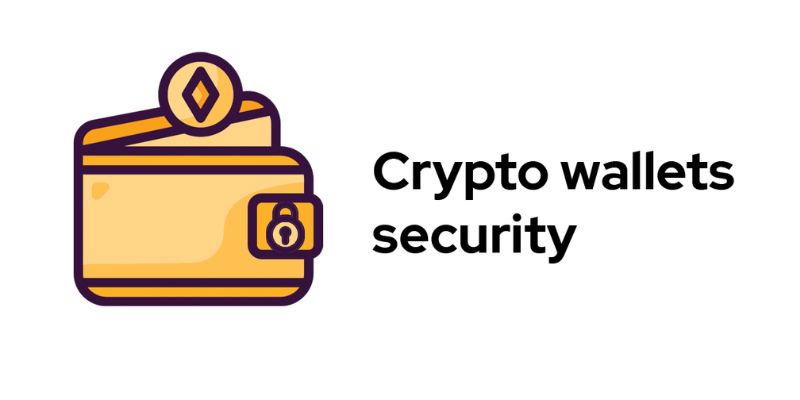How to secure a crypto wallet for beginners—it’s like locking your digital treasure chest. Picture your wallet brimming with crypto coins, shimmering with potential. But what if someone snatched that chest away? I’m here to hand you the sturdy padlock and teach you the tricks that’ll keep the crypto pirates at bay. You’ll learn to handle private keys like a pro and pick a wallet that’s a Fort Knox for your digital gold. No jargon, I promise. We’ll break it down simple and clear—so let’s gear up and make sure your crypto stays as safe as in a dragon’s lair.
Understanding the Basics of Crypto Wallets
Different Types of Crypto Wallets and Their Vulnerabilities
There are two main types of wallets to keep your crypto safe. You have hot wallets and cold wallets. Hot wallets connect to the internet and are handy for quick trades. But they can be targets for hackers. Cold wallets, like USB devices, don’t touch the net as often. They are best for holding crypto safely for a long time. Yet, if you lose them or forget your access codes, you may never get your crypto back. So each wallet has its own risks.
Knowing these risks helps you guard your digital money. Check the wallet’s features, so you get the best for what you need. Read reviews and learn from others who use the wallet. A strong start is half the battle in securing digital assets.
The Importance of Private Key Safety and Management
Your private key is like a super-strong password. It’s a string of numbers and letters that lets you access your crypto. It’s top secret, and you must keep it safe at all costs. If someone else gets it, they can steal your coins.
To stay safe, write down your private key and store it away from the internet. Think safe or locked drawer. A paper can’t be hacked! Don’t share it online or with anybody you don’t trust 100%.
Using a hardware wallet gives your private key an extra shield. It stores your key off your computer. This means a hacker can’t reach it through the internet. They would need the physical device, which you keep locked up.
For even more safety, add two-factor authentication to your wallet. That means two steps before you can get in. It’s like having a double lock on your door. Nobody gets in unless they have both keys. So if one step fails, you have a backup.
Remember to back up your key too. If you lose it or it gets damaged, you’ll need another way to get into your wallet. Without this, you could lose your crypto forever.
Learn about these things now so you’re ready later. Because once you’re in the crypto world, you’ve got to keep your own money safe. Practice these tips, and you’ll be ahead of the game.
It’s normal to feel a bit overwhelmed with all this info. But take it step by step. As you learn each part, you’ll become confident in safeguarding your bitcoin wallet and other digital money. These are the first steps in your beginner’s guide to wallet security.
Always remember: your cryptocurrency’s safety starts with you. And securing it doesn’t have to be scary. It’s all about learning the ropes, one knot at a time. When you understand your wallet’s ins and outs, you’re building a fortress around your digital treasure.
Setting Up Your Wallet Securely
Choosing and Configuring a Hardware Wallet for Maximum Security
When you jump into the crypto world, think of your wallet like a secret vault. It’s where you stash your digital coins, like Bitcoin or Ethereum, and keep them from bad guys. But to do that, you need the right kind of wallet. For top-notch security, hardware wallets are the way to go. They’re like secure USB sticks for your crypto.
To set one up, pick a trusted hardware wallet. Think of brands like Ledger or Trezor. They are like a safe in the crypto world that won’t let you down. When you have one, follow the steps it gives you. Here’s a simple roadmap:
- Plug the hardware wallet into your computer.
- Download the software it tells you to.
- Create a new wallet on the device.
- Write down the seed phrase it shows. This seed phrase is a super-secret key to your crypto vault. Don’t lose it, and keep it offline. Like in a safe or hidden spot nobody knows but you.
- Set a personal PIN on the device for an extra lock on your vault.
- Finally, move your digital coins to your new wallet.
There, now your cryptocurrencies live on a wallet that hackers can’t touch. They’re much safer than online wallets or apps.
Step-by-Step Guide to Activating Two-Factor Authentication
Now for an extra layer of armor. It’s called two-factor authentication (2FA for short). This means that to get into your wallet, you need something more than just a password. You also need a special code that only you can get.
Here’s how to turn on 2FA:
- Find the settings or security section in your crypto wallet app.
- Look for an option that says “Two-Factor Authentication” or something with “2FA.”
- The app will ask you to choose a way to get your 2FA codes. You can pick a text message (SMS), an email, or an app like Google Authenticator or Authy.
- Decide which one feels best for you and follow the steps it tells you.
- If you choose an app, you’ll scan a QR code with your phone. This will link your wallet to the app.
- Once set up, each time you log in, you’ll enter your password and the 2FA code you get.
By setting up 2FA, you tell the online world, “Show me you’re really me.” And unless they’re standing next to you or have your magic code-generating device, they can’t. This keeps your crypto extra safe, as safe as a bear in a bear-proof trash can.
Remember, protecting your crypto is like wearing a helmet when you ride a bike. You hope you won’t need it, but boy, are you happy it’s there if you take a tumble. With these wallet security steps, you’re not just riding free. You’re riding smart.
Maintaining and Protecting Your Crypto Investments
Regular Backup Strategies and How to Execute Them Effectively
Keep your crypto safe by backing up often. Think of backups like safety nets. If something goes wrong, your backup catches you. To start, pick a method. Use hardware wallets, USB drives, or paper. Yes, paper works too! Put your backup in several spots. Some folks keep one at home and one with a trusted friend. Here’s how you do it:
- For hardware wallets, back up on another hardware device or write down your seed phrase.
- For mobile wallets, use the app’s backup feature and secure your seed phrase somewhere safe.
- Paper is old-school but not to be overlooked. Write down your private key and store it securely.
Remember, your private key must stay private! If you share it, someone might steal your coins.
Identifying and Avoiding Common Scams and Phishing Tactics
You’re a target for tricksters wanting your crypto. Know their moves so you can block them. Stay sharp and you’ll stop scams in their tracks.
Scam email? Don’t click. Scammers love phishing emails. These look real but are fake. They want you to enter your details. Instead, delete the email. Always check where an email came from. If unsure, visit the company’s official website without clicking any links.
Got a message about free crypto? It’s a classic trap. True story: there’s no free lunch, especially with crypto. Ignore these offers. They’re bait.
Downloading a wallet app? Make sure it’s legit. Look at reviews, check the company, and download only from official stores. Fake apps are out there, waiting to swipe your coins.
Phone keeps ringing? If they say they’re from ‘support’ and need your key, hang up. It’s a con. No real support team will ask for that.
Remember, securing your digital assets is key. Use these tips to safeguard your bitcoin wallet and any crypto you own:
- Enable two-factor authentication for wallets.
- Update software for wallet protection.
- Learn the best practices in crypto security.
- Keep updated on avoiding scams in crypto.
Stay safe out there! Protecting your investment is all about knowing the tricks and being ready. Keep your eyes open, use common sense, and your crypto will stay yours.
Advanced Protection Measures for Your Crypto Wallet
The Role of Encryption and Multi-Signature Setups in Enhancing Security
Encryption is a mighty shield for your wallet. It locks your assets behind a secret code. Only you have the key. This way, no one else can touch your crypto. Always pick a strong password. Make it a mix of letters, numbers, and symbols. Never share it.
Multi-signature setups are like having several keys for one lock. It means you need more than one password to open your wallet or to send crypto. This is great for extra safety. If one key gets lost or stolen, your crypto is still out of reach. Many eyes and hands keep your treasure safe.
Updating Practices and Utilizing Antivirus Software to Safeguard Your Digital Assets
Always keep your wallet’s software fresh and up-to-date. Think of updates as fresh armor for your digital wealth. Hackers find it hard to attack when your defenses are new. Set reminders to check for updates. Make it a habit, like brushing your teeth.
Antivirus software keeps nasty bugs away from your wallet. Just like washing hands keeps germs away. Install trusted antivirus and keep it running. It’s a silent guardian watching over your crypto. Regular scans catch sneaky threats that try to slip in.
Use these steps, and sleep tight knowing your crypto is safe.
To wrap it all up, we tackled the basics of crypto wallets and noted key steps to stay safe. We learned about wallet types, how to keep our private keys secure, and ways to set up wallets with care. We walked through configuring hardware wallets, turning on two-factor authentication, and checked out ways to back up and protect our crypto. We also learned to spot scams.
At every step, staying alert and informed is key. Regular updates and smart setups like encryption and multi-signature can make a big difference. This journey into crypto safety isn’t just smart; it’s vital. Keep these tips close and your digital treasure safer. Stay sharp, stay secure, and keep investing with confidence!
Q&A :
What are the first steps to securing a cryptocurrency wallet for beginners?
Securing a cryptocurrency wallet starts with choosing a reputable and reliable wallet that fits your needs, whether it’s a hardware wallet for optimal security or a software wallet for ease of use. Always download wallets from official sources to avoid malicious versions. Begin by setting a strong and unique password, activating two-factor authentication (2FA), and always keeping the software up to date. It’s crucial for beginners to familiarize themselves with their wallet’s security features and to follow best practices consistently.
Are hardware wallets the best option for new crypto users to ensure security?
For many beginners, hardware wallets are considered one of the safest options to secure cryptocurrencies due to their offline nature, reducing exposure to online threats. Unlike online or software wallets, hardware wallets store private keys on a physical device, not connected to the internet. This “cold storage” approach is less susceptible to hacking. Although highly recommended, hardware wallets also require a basic understanding of their operation, so it’s important for new users to follow the setup guides carefully and only purchase from trusted manufacturers.
How can I protect my cryptocurrency wallet from hackers?
To protect your cryptocurrency wallet from hackers, employ multiple layers of security. Start with a robust password and never use the same password across different platforms. Activate two-factor authentication (2FA) for any login process. Be cautious with wallet backups; encrypt them and store them in multiple, secure locations. Update the wallet software regularly to patch any vulnerabilities. Finally, be wary of phishing scams by double-checking sources and never revealing your private keys or seed phrases to anyone.
What should a beginner know about backup and recovery options for a crypto wallet?
A beginner should know that backing up and recovering a crypto wallet involves recording and safely storing the recovery seed phrase, a unique set of words generated by the wallet that allows access to the funds. It’s crucial to write down this seed phrase on paper and store it securely, such as in a safe or deposit box – never on a computer or online. Some wallets may offer additional backup methods, but the seed phrase is typically the most important. In case of wallet loss or failure, this phrase can be used to restore access to your assets on a new wallet.
Is it necessary to use a VPN when managing a cryptocurrency wallet?
Using a VPN (Virtual Private Network) can enhance security when managing a cryptocurrency wallet, especially when connected to public or insecure Wi-Fi networks. A VPN encrypts your internet connection, making it more difficult for hackers to intercept and gain access to your financial information. While not strictly necessary for every transaction, regularly using a VPN provides an additional layer of online privacy and protection against potential threats, which is beneficial for both beginner and experienced users of cryptocurrency wallets.



